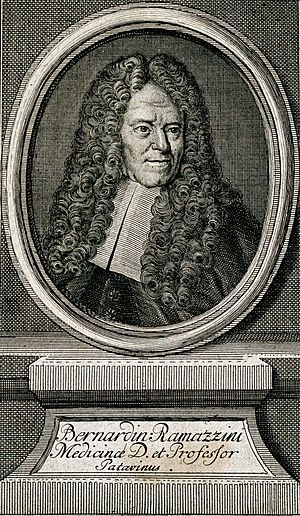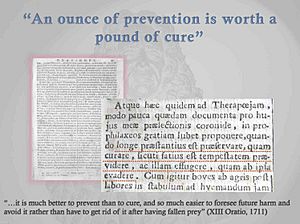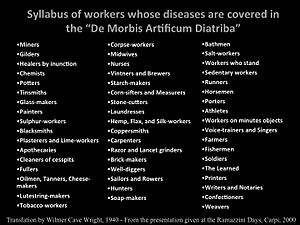Bernardino Ramazzini facts for kids
Quick facts for kids
Bernardino Ramazzini
|
|
|---|---|

Bernardino Ramazzini
|
|
| Born | 4 October 1633 Carpi
|
| Died | 5 November 1714 (aged 81) |
| Nationality | Italian |
| Alma mater | University of Parma |
| Known for | cinchona, occupational medicine |
| Scientific career | |
| Fields | medicine |
| Institutions | University of Modena, University of Padua |
Bernardino Ramazzini (Italian pronunciation: [bernarˈdino ramat'tsini]; 4 October 1633 – 5 November 1714) was an Italian physician.
Ramazzini, along with Francesco Torti, was an early proponent of the use of cinchona bark (from which quinine is derived) in the treatment of malaria. His most important contribution to medicine was his book on occupational diseases, De Morbis Artificum Diatriba ("Diseases of Workers").
Life
Ramazzini was born in Carpi on 4 October 1633 according to his birth certificate. He studied medicine at the University of Parma, where his interest in occupational diseases began.
Career
He was appointed to the chair of theory of medicine at University of Modena in 1682 then served as professor of medicine at the University of Padua from 1700 until his death. He is often called "the father of occupational medicine"
The first edition of De Morbis was published in 1700 in Modena, the second in 1713 in Padua.
Occupational medicine
His book on occupational diseases, De Morbis Artificum Diatriba (Diseases of Workers) outlined the health hazards of chemicals, dust, metals, repetitive or violent motions, odd postures, and other disease-causative agents encountered by workers in more than fifty occupations. This was one of the founding and seminal works of occupational medicine and played a substantial role in its development.
He proposed that physicians should extend the list of questions that Hippocrates recommended they ask their patients by adding, "What is your occupation?".
Ramazzini saw prevention as being better than cure. In his Oratio given in 1711, he suggested that "it is much better to prevent than to cure, and so much easier to foresee future harm and avoid it rather than have to get rid of it after having fallen prey".
Malaria
In regards to malaria, Ramazzini was one of the first to support the use of the quinine-rich bark cinchona. Many falsely claimed that quinine was toxic and ineffective, but Ramazzini recognized its importance. He is quoted, "It [quinine] did for medicine what gun powder did for war."
Death
Ramazzini died in Padua on 5 November 1714.
Acknowledgement
In a lifestyle article "Sitting can lead to an early death," the writer acknowledged Ramazzini's pioneering study of this field in the 17th century.
The honor society Collegium Ramazzini is named after him.
Works
See also
 In Spanish: Bernardino Ramazzini para niños
In Spanish: Bernardino Ramazzini para niños





